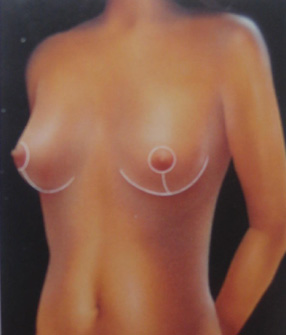Breast Lift - Mastopexy
If you consider breast lift surgery…
Breast Lift: A woman's breasts change over the years, due to factors such as pregnancy, breastfeeding and gravity. As the skin loses its elasticity, the breasts begin to sag by losing their shape and tightness. Breast lift, also known as mastopexy, is a surgical procedure intended to lift and reshape sagging breasts at least once.
However, it should be remembered that no surgical procedure can permanently prevent the effects of gravity!
In mastopexy, the size of the dark skin around the nipple called the areola can be reduced as well. If your breasts are too small or have lost their volumes due to weight loss or post-pregnancy changes, both their tightness and size can be increased by placing breast implants through mastopexy. If you consider mastopexy, this brochure will give you basic information about when it might benefit you, how it is performed, and what results you can expect. This brochure cannot answer all of your questions, as there are many things depending on patients and surgeons. If there is anything you don’t understand, please ask your surgeon.

Best candidates for Breast Lift (Mastopexy)...
Breast lift surgery makes a big difference compared to your old situation by restoring your ideal appearance and self-confidence. Before deciding on this surgery, discuss your expectations with your surgeon and carefully evaluate the information you receive.
The best candidates for mastopexy are healthy, mentally balanced, realistic women who can conceive the improvement that the surgery can provide. The best results are usually obtained in women with small, saggy breasts. It is possible to lift breasts of any size, but the permanence of the results is relatively shorter in large breasts.
Many women explore the topic of mastopexy because pregnancy and breastfeeding leave behind loose skin and breasts that have lost volume. If you consider having a baby again, it may be a good idea to postpone your breast lift surgery. It has no special risks that will affect your future pregnancies (for example, mastopexy usually does not affect breastfeeding). However, pregnancy can create tension in your breasts, returning the breasts to their previous state.

The female breast begins to sag in the course of time due to factors such as gravity and childbirth.

A piece of skin is removed from the upper part of the breast to move the nipple and aerola to their new position.
All Surgeries Involve Risks...
Breast lift is not a simple surgical procedure. However, it is safe when a qualified plastic surgeon performs it. However, the possibility of complications and reaction to anesthesia, which all surgical operations involve, is involved by this surgical procedure as well.
Despite being rare, bleeding and infections after mastopexy can cause scar enlargement.
You can minimize the risk of complications by strictly following your surgeon's instructions before and after the surgery.
Mastopexy can leave permanent scars in places that can usually be hidden by bras and bathing suits. Inadequate healing and extensive scars can be more common in smokers. After the procedure, you may also experience slight loss of sensation and there may be slight changes in the positions of your nipples.
Planning of Breast Lift Surgery
It is very important to speak openly about your expectations and give ear to your surgeon's opinions during your first consultation. Each patient and doctor may think differently about the desired breast size and shape.

To reshape the breast, the edges of the skin on the lower part are brought closer to each other.

After the aerola is sutured in its new place, the incision under the breast is sutured. As a result, the scar remains in the natural inframammary fold.
Your physician will examine and measure your breasts while you are sitting or standing. He/she will discuss with you about factors such as your age, the expected size and shape of your breasts, the condition of your skin, and whether implants will be recommended (for more information about implants, request the breast augmentation brochure!). You should also discuss the final position of the nipple and areola. The nipple, which may be close to the inframammary fold, can be moved to a higher position during the surgery.
Your surgeon will give you details about the procedure, after explaining the possible consequences, risks and scars, and making sure that you understand and accept all of them. He/she will also specify the type of anesthesia to be performed, and the facilities and costs of the hospital, where the surgery will be performed.
Do not hesitate to ask your physician any question in your mind, especially the ones about your expectations and concerns regarding the result.
Preparation for Breast Lift Surgery
Depending on your age and family history, your surgeon may ask you to have a mammogram before surgery. Your surgeon will also give you special instructions about how to prepare for the surgery. In these instructions, he/she will mention about issues such as eating, drinking, smoking habits, and certain vitamins and drugs that you should take or avoid.
You will need a patient accompanist who will take you home when you are discharged after the surgery, and who will help you go out on the first or second postoperative day.
Where will your surgery be performed?
Breast lift surgery is performed in hospitals. To be more acceptable and cheaper, it usually does not include hospitalization. If you have applied for hospitalization, you should prepare yourself to stay in the hospital for a day or two.
Types of Anesthesia:
Your physician may prefer general anesthesia, and you sleep throughout the operation.
Especially in suitable patients operated with smaller incisions, operations can be performed under local anesthesia supported with sedative drugs. When you come out of anesthesia, you feel a very slightly uncomfortable.
Breast Lift Surgery:
Mastopexy usually takes 1.5 to 3.5 hours. The anchor-shaped incision technique that follows the natural breast lines is the most common one among the various incision techniques.
The incision line is between the breast skin to be removed and the new location of the nipple. After the removal of the excess skin, the nipple and areola are brought up to a higher position. The skin surrounding the areola is then pulled down and conjoined to reshape the breast. Sutures are usually positioned around the areola, extending downward from the nipple area, as a vertical line and along the lower crease of the breast
Some patients with small breasts, especially those who have minimal sagging, may be good candidates for the procedures which involve smaller incisions. An example of such procedures is “donut” mastopexy, a special mastopexy technique that involves the removal of a circular piece of skin with a hole in the middle, which is created with circular incisions made around the areola.
If an implant will be placed under your breast after the lifting process, it is placed directly in the pouch created under the breast tissue or under the chest wall muscle.
After Surgery:
After surgery, you will use an elastic bandage on gauze patch or a recommended surgical bra. You may have slight bruising and swelling in your breasts for a day or two, but the pain will not be severe. All the discomforts you feel can be treated with drugs prescribed by your physician.
Within a couple days, the bandage and surgical bra are replaced by a soft supportive bra. You will need to wear that bra on the bandage for three or four weeks. The sutures will be removed after a week or two.
If your breast skin is excessively dry after surgery, you will need to apply a moisturizer many times a day. During the application, keep the moisturizer away from the suture area and be careful not to stretch the skin.
After the surgery, loss of sensation may occur in the nipple and skin due to swelling. This loss of sensation usually goes away after six weeks as the swelling subsides gradually. However, this condition may last for a year or even years in some patients, and despite being rare, it may also be permanent.
Getting Back To Normal:
Healing is a gradual process. Even if you will be able to get up after a day or two, plan your schedule by considering that you will not return to work for a week or more. Avoid lifting any object above head level for three to four weeks. If you have any unusual signs of discomfort, don’t hesitate to inform your surgeon.
Your surgeon will give you detailed instructions regarding how you will resume your routine activities. He/she may ask you to avoid sexual intercourse for a week or more and strenuous exercises for a month. You can then gradually return to such activities. If you got pregnant, the surgery will definitely not affect your ability to breastfeed as long as the milk ducts and nipple remain intact.
Your New Appearance After Breast Lift Surgery
Your surgeon will do his/her best to make your scars as less noticeable as possible. However, it is always important to remember that mastopexy may leave extensive and permanent scars. These scars sometimes remain lumpy and red for months, and then they gradually lose their markedness, and sometimes fade leaving a thin white line. Scars are usually positioned so properly that they even allow you to wear low-cut dresses.
It should also be remembered that the results of mastopexy will not last forever. Changes may occur in your breasts due to the effect of gravity, pregnancy, aging, and weight gain. Women who have implant placement in conjunction with breast lift surgery may achieve longer-lasting results.
If you understand the whole procedure and have realistic expectations, the result of the breast lift surgery will be more satisfactory for you.




